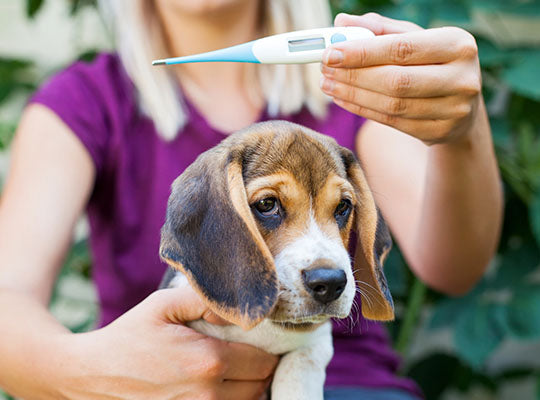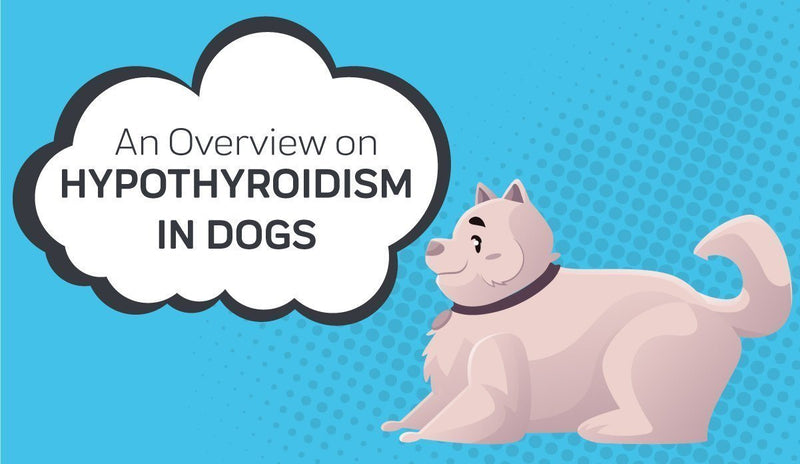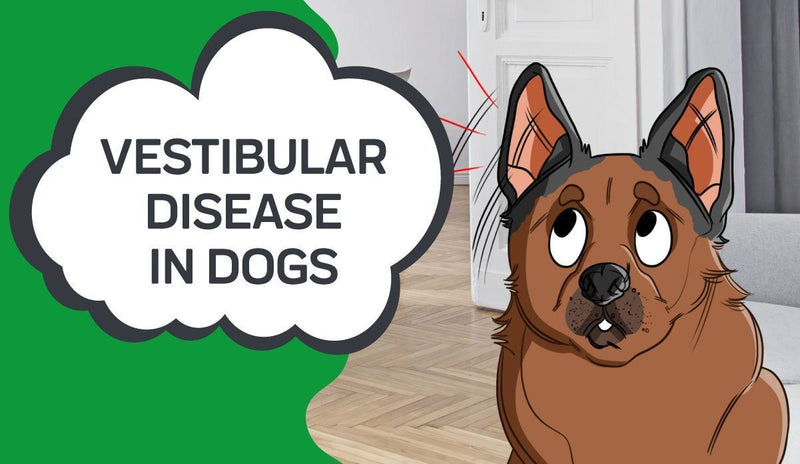- What Do you Do If Your Dog Shows Signs of Fever?
- Fever in Dogs: What are the Causes?
- How to Tell If Your Dog Has A Fever
- Lowering Fever in Dogs
- Treatment: What you can Do If Your Pet Has a Fever
- Why Should You Use Natural Treatments?
- Fever in Dogs Conclusion: Keeping Your Dog Safe
My dog has a fever, now what? As a pet parent, among the worst feelings it is possible to experience is seeing your dog or cat in pain and feeling unable to help him or her. Fevers are a very common occurrence in humans and animals alike and often are a symptom of an underlying illness or condition.

If your dog has fever symptoms, you might be tempted to try and treat him yourself to assist in reducing the fever, as well as nurse the pet’s health back to normal. But it’s vital that you be educated about what’s safe to offer your pup for a fever before you take any actions. Here’s a guide on how to tell if a dog has a fever, what causes a fever in dogs, and what it’s possible to do to aid in abating the symptoms of the dog fever.
What Do you Do If Your Dog Shows Signs of Fever?
Is your dog running a fever? Fever's have several different causes, symptoms, and treatments and depending upon how high the dog's body temperature is, you might have to take him to the hospital. If you are worried that your dog’s temperature is too elevated, it’s possible to get a thermometer at the local pet store. Remember, a human thermometer won’t work!
Have you ever noticed that your furry friend has not been feeling well lately? How do you know if your dog has a fever? You know he has to be sick because he’s coughing, you have noticed he has been a little lethargic, and despite the warm ears, he’s shivering. Your dog has a fever, or in clinical terms, pyrexia.

Canines normal body temperature ranges from 99.5 to 102.5℉, and our thermometers oftentimes struggle reading temperatures which exceed 103℉. If your dog’s temperature reads above 106℉, it’s considered a clinical emergency, and you ought to take him to the hospital as soon as you can.
Fever in Dogs: What are the Causes?
A few of the causes of dog’s fever are simple to diagnose, while other ones are more challenging. Some causes involve infection or inflammation, like an infected bite or cut, ear infection (more on that later), urinary tract infection (more on that later), abscessed or infected tooth, as well as infected organs.
Diseases which may cause a fever involves a continuous viral or bacterial disease, metabolic diseases, and endocrine diseases. Fevers also may come about because of what your pup is placing into his body. If you vaccinated your dog recently, it’s vital that you know that they’re able to get a fever for a couple of days afterward. Try and keep him comfortable as he endures the fever. It ought to be gone in no time.
A few dog medicines also can lead to fevers; therefore, if you have placed your dog on a new medicine, check out the side effects to see if it’s where his fever derived from. Also, an allergic reaction may cause the dog’s temperature to increase. Try and give consideration to any new plants or additional items you might’ve purchased recently that might be upsetting his immune system.
If your pet tends to get into human things, he might’ve consumed something which made his temperature increase. Look to see if your pet has gotten into toxic plants, antifreeze, human foods, or human medicines. Dogs, at times, may catch a fever from unknown sources, which may be the case if your pup has immune system irregularities, bone marrow or blood disorders, as well as cancer.
How to Tell If Your Dog Has A Fever
How do you tell if your dog has a fever? There are a multitude of tell-tale signs that your dog is suffering with a fever.
Fever symptoms in dogs involve:
- Nasal discharge
- Depressed mood
- Shock
- Increased respiratory rate
- Dehydration
- Rapid heart rate
- Weakness
- Vomiting
- Coughing
- Loss of appetite
- Shivering
- Warm and dry nose
- Warm ears
- Lethargy or lack of energy
- Red eyes
Lowering Fever in Dogs
Seeing your pup endure a fever may be uncomfortable, yet you’re able to make him feel better. Contacting a vet to check if your dog has a fever and see if there is a more severe problem is an excellent first step. The next thing it’s possible to do to make your dog more comfortable is to apply cold water around his ears, as well as paws to help him cool down.
In addition, you should ensure that his bowl of water is close to him to make it simpler for him to consume his water. Be certain that you closely observe him when he feels this way. Search for signs that he’s getting worse or getting better. Other measures to take to keep the dog cool involve wrapping ice packs inside a towel and putting it on his abdomen and chest then blowing a fan within his direction.
The most critical thing to remember at this time is that your dog isn’t feeling well and the more comfortable the dog is, the better he’ll begin to feel.

Treatment: What you can Do If Your Pet Has a Fever
It’s vital that before you attempt to treat the dog, you speak with a licensed vet to ensure that the measures you’re taking won’t do more harm than good. Most dog parents jump to wanting to offer their pup human medicine to decrease fever, yet most human medicines may be toxic to canines, especially if given in improper dosages.
Some vets might suggest giving your pet a low dose of a human being over-the-counter medicine to assist in bringing the fever down, while other ones might want to do a physical exam before starting any type of fever reducers or medicine so that the symptoms aren’t hidden.
Always contact the vet before you administer any kind of medicine to your pet to check that it’s safe and determine the proper dosage. While you might not have the ability to give the dog anything for his fever, there are a variety of steps to take to assist in bringing the fever down without OTC meds.
To assist in reducing the dog's fever, apply cold water to the ears and paws using a soaked cloth or towel. If you can, try and coax the dog into drinking cool water to assist in ensuring hydration is maintained.
Why Should You Use Natural Treatments?
Innovet Pet Products offers CBD Oil for dogs and cats. Our products offer a natural, safe pet alternative, which pet owners may utilize without fear. For that reason, most pet owners browse alternative meds for dogs, yet what they are actually seeking is a natural and safe alternative to animal prescription meds. The best alternative to animal meds is natural supplements and proper diet. Similar to people, if we can, we prefer to change our diet, as well as consume natural supplements, opposed with consuming prescription meds for the remainder of our lives. Most pet owners are now turning to natural remedies for canines such as botanical supplements that aid in alleviating some of the health problems which originally drove them to utilize pharmaceuticals. As a dog parent considering a more holistic animal care approach, it is vital to discover the best health routine for your dog or cat. Whether it means the use of pharmaceuticals along with natural supplements or changing to only natural supplements for the dog. Each pet is unique, similar to every human being unique. The great news is that Innovet Pet Products may be used along with any of your dog or cat’s present medicine and easily can fit into any dog or cat’s daily regimen.Fever in Dogs Conclusion: Keeping Your Dog Safe
If you suspect that your dog has a fever and has many of the symptoms mentioned above, please don't panic. Be sure to try and keep your dog hydrated and watch over them like you would watch over a child. There is a good chance the fever will pass but it's important to keep an eye on your fur-baby to make sure they are doing ok. Find a dog thermometer and take your dog's temperature on a regular basis until you know their fever has passed and they are running a normal temperature. Lastly, Never Give your dog Human Medicines!
Sources:
Uncovering the Cause of Fever in Dogs
Fever of Unknown Origin in Dogs

Sara Redding Ochoa, DVM was raised in north Louisiana. She graduated from LA Tech in 2011 with a degree in animal science. She then moved to Grenada West Indies for veterinary school. She completed her clinical year at Louisiana State University and graduated in 2015 from St. George’s University. Since veterinary school she has been working at a small animal and exotic veterinary clinic in east Texas, where she has experience treating all species that walk in the hospital. In her free time, she likes to travel with her husband Greg, bake yummy desserts and spend time with her 4-legged fur kids, a dog Ruby, a cat Oliver James “OJ”, a rabbit BamBam and a tortoise MonkeyMan.
Thanks for stopping by!
P.S. We Love You!
Sincerely,
The Innovet Team
Please do not ask for emergency or specific medical questions about your pets in the comments. Innovet Pet Products is unable to provide you with specific medical advice or counseling. A detailed physical exam, patient history, and an established veterinarian are required to provide specific medical advice. If you are worried that your pet requires emergency attention or if you have specific medical questions related to your pet’s current or chronic health conditions, please contact or visit your local/preferred veterinarian, an animal-specific poison control hotline, or your local emergency veterinary care center.
Please share your experiences and stories, your opinions and feedback about this blog, or what you've learned that you'd like to share with others.

















